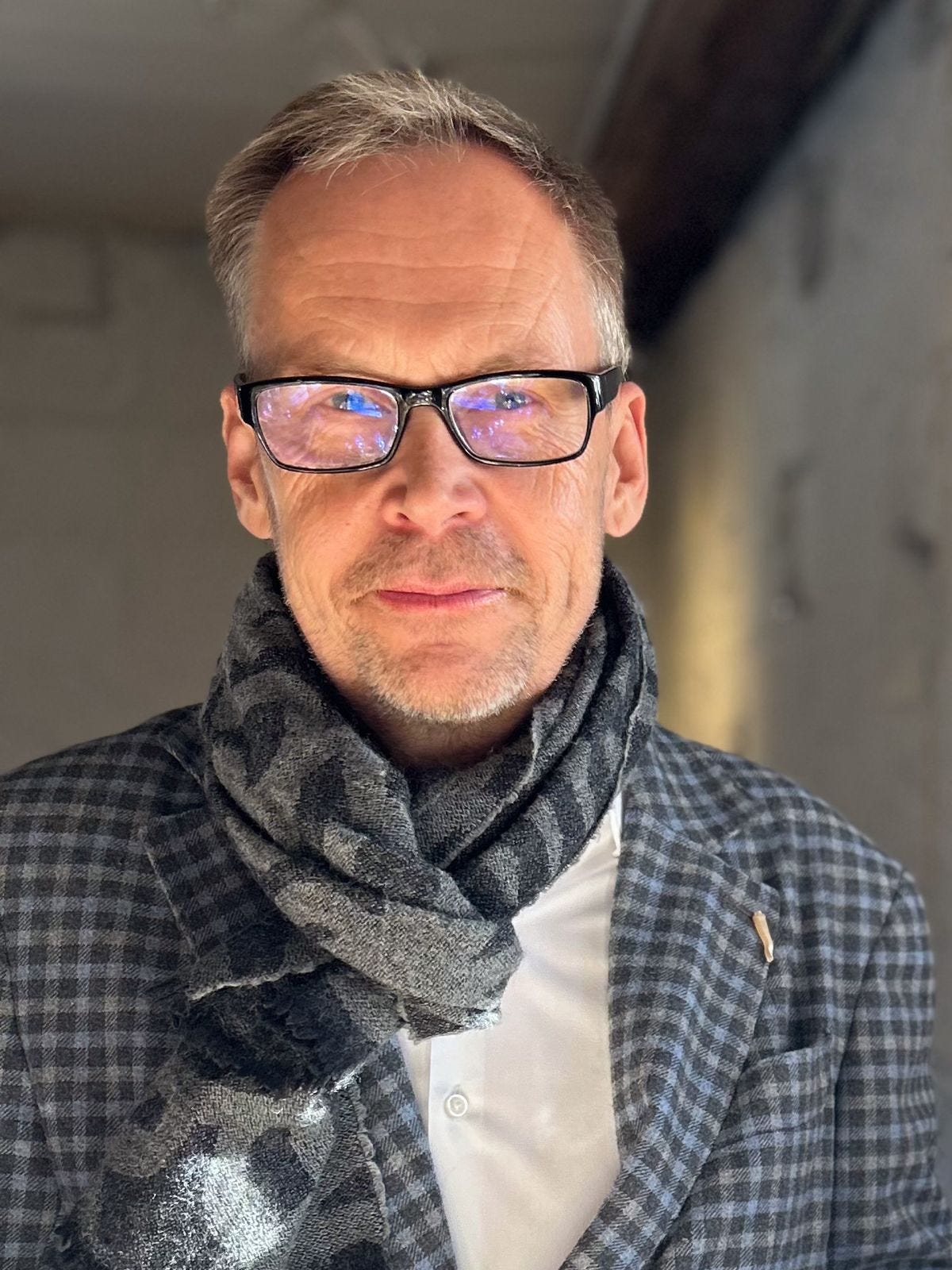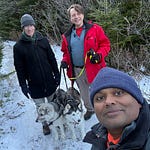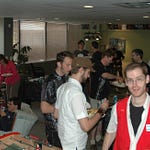In 2007, I joined an open-source database company called MySQL AB. While I was at BioWare, I was part of the team that built the BioWare Community, which launched with the game Neverwinter Nights in July 2002. In a future episode or two, my friend and I will be delving into the nerdiest of stories around those times that even the most dedicated BioWare fans have likely not heard. But back to the story... During the process of building the community, we had to do many things that were new to the time. For the scale we were looking for, we had to use an open-source database called MySQL; in fact, we had to use an alpha version due to what we needed to do. Yes, we launched the Neverwinter Nights community—one of the most important things we as BioWare had done as a business—to millions of people on an alpha version of MySQL 4.0. I was hooked on this database software.
Many years later, as a BioWare staff member now helping to run a very highly-trafficked database, I attended the MySQL conference in Santa Clara, California, to see if I could learn a thing or two. There I met the CEO of MySQL AB, Mårten Mickos, and I had this unshakeable feeling that I just had to be part of this open-source database story. I scoured their job listings, and they were looking for a web programmer working with Jeff Wiss and the MySQL Marketing team. To many people, this seemed a step down from where I was going at BioWare. For me, it was a chance to learn about a totally different type of business. I had no idea then how life-changing that decision really was. My career as a web programmer lasted all of a year before I joined Kaj Arnö's team at MySQL to become the technical community manager for North America, working for Giuseppe Maxia.
My first company meeting with MySQL AB was quite different from anything I had witnessed up to this point. I really didn't know Nordic, let alone Finnish culture. The CEO, Mårten, finished that very frank and open meeting with a shot of vodka. I followed along remotely in Montreal, using the MySQL shot glass I had been gifted as part of joining the team. When Sun Microsystems bought MySQL AB for the then-astronomical sum of 1 billion dollars in 2008, Kaj, Monty, Mårten, Zack, and others led the company in a rousing Finnish drinking song called "Helan Går."
This is my first-ever two-part episode. It is a wide-ranging conversation with my now-dear friend Kaj Arnö while visiting him at his home in Nagu, Finland, in the Finnish Archipelago south of the town of Turku (also known in Swedish as Åbo). The interview was recorded while walking near Kaj's house in Nagu with his young son. It was a bit windy, so please pardon the various noises of us playing football and frisbee on a windy archipelago day.
[Listen] In true MySQL tradition, let's start with Kaj doing "Helan Går" in his kitchen.
A Conversation in Nagu: Kaj Arnö on MySQL, MariaDB, and the Dawn of AI
Dups: Kaj, you are my former colleague, my former boss even. We have been partners in building software and friends for a very long time. In fact, you are one of the prime reasons I moved to Finland. So here we are, walking down a lovely country road in Nagu, having a conversation. Tell me a little bit about yourself and how we met, because it all started with a database called MySQL.
Kaj: Yes. First of all, I have to tell you how I ended up in Nagu, and that's because of genetics. Lots of my ancestors come from here. I hadn't been in Nagu more than a couple of times until I was seven years old, when my father's aunt died and we inherited her place. I've been here every summer for more than 50 years. I think it is sort of the center of the universe in many respects, and that's why you and I ended up here right now.
But how did we end up working together? That's MySQL, or some people pronounce it My-S-Q-L. At that point in time, it was the biggest open-source database and, by a couple of measures, still is.
Dups: What is MySQL, and why did it change the world?
Kaj: MySQL is a database. If you look at what is needed in IT, the most fundamental thing is the operating system, which makes the computer work at all. But the second most important thing is how you store things. Where do you store not just your written documents, but all of your data in a structured form? That predates any of the open-source databases; we've had databases since computers were invented. But applying open-source logic to databases—that's what created MySQL. It addressed the second biggest domain in IT, and MySQL was and still is the key database in that realm.
Dups: At the time I joined MySQL in 2007, it was already a very successful company. One of the attributions to that success is that it was the foundation for something called Google.
Kaj: And I believe something called Facebook.
Dups: Oh, yes. Something called LinkedIn.
Kaj: Yes.
Dups: And I think at that time, something called Twitter. It's called something else now.
Kaj: Yes, it was the foundation for about 18 out of the 20 biggest websites at the time.
Dups: Do you think that all those services we became so enamored with probably wouldn't have happened if they had to pay for a database from someone like Microsoft or Oracle?
Kaj: It most definitely would not have happened without an open-source database. You can, of course, ask, "Is it all thanks to MySQL?" And I would say no. It's about the timing. MySQL happened at the right point in time, and if MySQL hadn't been there, then a year later something else would have filled that spot in a slightly different way.
MySQL filled it in its own particular way, which is based on the pragmatism of a database that does the basic things right. Stability, performance, and ease of use were the keywords. Other databases have other criteria, but the web as we know it wouldn't have happened without open source.
Dups: But I seem to remember, if I recall correctly—and the founders were Monty Widenius and David Axmark...
Kaj: Yes, Monty and David.
Dups: The original MySQL was actually shareware. Was that not the case?
Kaj: You're right. In 1995, it wasn't yet formally open source, and the term "open source" wasn't really used at that point; it was more "free software." The point in time where they decided to go with a formal open-source license, the GPL version 2, and not shareware, was in the year 2000. So you're correct.
Dups: If I remember correctly, you have been friends with Monty and David for a long time.
Kaj: With Monty since the '70s and with David since the mid-'80s. So it's been a fairly long history.
Dups: And how has Nagu figured into that history?
Kaj: We have a common friend who has been arranging so-called midsummer parties here on Biskopsö in Nagu since 1989. Hence, all the people around MySQL come here very, very frequently. Also, the CEO of MySQL AB, Mårten Mickos, has had a place in Nagu since 1966 or so.
Dups: So, Nagu is almost central to the history of MySQL.
Kaj: It is, absolutely. And I think this is not just a figure of speech or a romanticization. It is also the culture that you have in the Nordics, where there are two concepts that are very conducive to open source. One of them is Allemansrätt and the other one is talkoot. Talkoot is more a Finnish word; Allemansrätt is more a Swedish word. Allemansrätt means "the right of everyman," where you can, here in Nagu, if you find a place you want to go with your kayak, you can go there. There's no need to ask for the permission of the landowner. Yes, it's privately owned, but part of this right is to land on an island and camp there. That, I think, has led to a focus on underlying societal needs as opposed to just selfish needs.
The Finnish word talkoot means that you help each other. Today, you're building your house. Okay, I help you. There's no financial compensation, but there's an implicit expectation that when I build my house, you help me.
Dups: You played many roles in the MySQL organization as it grew. What are some of the things that you did?
Kaj: I started by doing training because we realized at MySQL that you need people who know the product. Some users learn by themselves, but not everybody does. The organization at MySQL was, of course, an ad hoc one at first, where people would fulfill many roles. An engineer could sometimes answer support calls and sometimes develop the software. We didn't differentiate in the beginning between support engineers and developers, which is the most basic division of roles in any organization. Over the years, those roles became much more specific. My role was in the transitioning of an ad hoc organization to a mature one. I was VP of Engineering, I was VP of Services. I said jokingly that except for CEO, the only roles I did not have were being in charge of sales or finance.
Interviewer: Then MySQL was sold to Sun Microsystems in 2008 for an astronomical number at the time: a billion dollars.
Kaj: That was astronomical at that point.
Interviewer: From there, the founders started a second open-source database called MariaDB.
Kaj: It's actually more the founder, Monty. David has been with us in a certain way also, but it's mostly Monty who realized this is not the end of the journey for creating databases. And the starting point of that was more Oracle buying Sun than Sun buying MySQL.
Dups: For those who don't understand how open source works, you can take any project and "fork" it to continue development on it. That's how MariaDB came about. But of course, MariaDB is very different from MySQL these days.
Kaj: Let me first protest against the comment that MariaDB is very different from MySQL. Of course, it is not MySQL; for the last 15 years, it has been something different. And if you think about development in 15 years, lots of things happen, so in that sense, you're completely correct.
But in another way, it is super similar. You can take an old version of MySQL and upgrade it to MariaDB with nearly no effort. And for those listeners who don't know what database upgrades are, I can tell you it's one of the most painful things you can do in IT. That is not the case between MariaDB and MySQL. One of the ways to profile MariaDB these days is to say that it is the future of MySQL. That is because the love needed to sustain an open-source project doesn't really seem to be there at Oracle any longer. The generations of people who originally developed MySQL are long since gone, and many are with MariaDB.
Dups: Once MySQL was sold and MariaDB was born, you had a new role. Several new roles, if I remember correctly. Where are you now, and what were those roles?
Kaj: I'm one of the founders of MariaDB Corporation. After that, I moved to be the CEO of the MariaDB Foundation, and now I'm the executive chairman of the MariaDB Foundation. Since about 2013, we have had a division in MariaDB between church and state. The foundation is about making sure that MariaDB is available for everybody—it's open, and we want it to be adopted by everybody. MariaDB Corporation is, in a sense, like any other startup built around developing MariaDB Server.
Dups: So, the most important question of our times: as we witness this revolution in software, what does having MariaDB, whose lineage dates back to the foundation of the modern commercial internet, mean for the future with the advent of AI?
Kaj: I would say first of all that the AI trend—or bubble or hype or thing—is bigger than the cloud. Yes, the cloud has a certain meaning, but if you look back at my professional life, having AI is about as big and exciting as it was to have your own computer and to have the internet at all. It is an order of magnitude bigger than most other innovations. It is fundamental.
And then your question, what does that mean for the database? One of the things I've learned, having worked in IT since the very early '80s, is that databases change very slowly. What that means in the era of AI is that I believe you shouldn't ask what AI can do for databases, but ask what databases can do for AI. The need for persistence, the need for storing data in a structured form, will always be there. It's a question of how you serve that need best for AI.
The original MySQL database grew together with a development environment, which was usually PHP. Now, I think the connection to AI is the crucial part. It's the thing we really need to make work well. The integration between the database and facilitating the easy use of that database when you're developing an AI tool—that is the key. And I think a relational database will remain at the core of storing user data for the foreseeable future, also in AI.
Dups: You have watched one more turn of the technology wheel than I have. I didn't get to witness the rise of the personal computer; I saw the rise of the internet, the cloud, and now AI. What does this moment mean for you as someone still involved in all of this?
Kaj: It involves excitement and joy. It's energizing. It's so cool to do "vibe coding," to see the new things you can do. It's like playing around with a new toy. Monty and I once traveled by boat from Finland to Sweden to buy 16 kilobytes of extra memory for our Z80 computers. And now my camera has 512 gigabytes on a tiny card. The world has changed completely, but what hasn't changed is the joy and excitement of getting new toys.
Dups: The reality is that the AI versions we have today suffer from some fairly big problems. Hallucinations, for one. Non-determinism that can be abused. How does that square with the joy and excitement?
Kaj: In that sense, it's no different from earlier. You could misuse stuff before as well. I remember a Finnish newspaper article about computer viruses, where a fairly senior IT expert said, "What kind of garbage is that? No viruses will ever influence computers. That's just bogus." And it wasn't bogus.
I think the adverse effects you mentioned, like hallucinations, are in a way nothing new under the sun. I'm not a naive technology enthusiast who thinks that everything is great for its own sake. But AI is different, and it brings back that excitement. I realize it's going to take jobs away, but I think it will create other jobs. I am also of the opinion that regardless of what I think or do, these things will happen, and I had better make something good out of it.
Dups: Thank you very much, Kaj, for coming on Tales Under the Cat Tree. It's been lovely visiting you here in Nagu and experiencing this place, as well as talking to you about our shared history and the history of MySQL and MariaDB.
Kaj: Thanks for having me.














